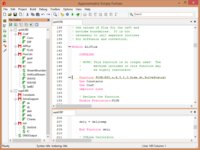
These reserved words cannot be used as identifiers or names. Then, write a Fortran program that calls this function from the DLL library and computes getSquare(100.RK). Keywords are special words, reserved for the language. Modify this function and provide the Intel Fortran Compiler command ifort with the required flags to generate Fortran DLL file that can be called from Fortran programs compiled by the same compiler. It must be composed of alphanumeric characters (all the letters of the alphabet, and the digits 0 to 9) and underscores (_).įirst character of a name must be a letter. Moreover I have no experience with the Makefile environment (this BASHrc-like things I am not familar with). And I really don't have a plan here what to do.
Simply fortran file outline code#
and data files Plenty of example code and thorough coverage of debugging. What I have to do that the module (see above code) is recognized properly It is recognized in File Outline, but it is not inside the 'module' folder. A name in Fortran must follow the following rules − Schaums Outline of Programming With Fortran 77 (Schaums Outlines) : Mayo. IdentifierĪn identifier is a name used to identify a variable, procedure, or any other user-defined item. To declare a le as being formatted, the ‘FORM’ specier is set to be the string 'FORMATTED' in the ‘OPEN. A token could be a keyword, an identifier, a constant, a string literal, or a symbol. 4 Formatted Files (text les) Formatted les are simply text les that we can look at in an editor like pico, there is nothing unusual about them, in fact the Fortran 90 codes that you write are saved as text les. Tokens are made of characters in the basic character set. simple input/output facilities, keeping data in files, an introduction to numerical meth(more). the special characters = : + blank - * / ( ). A basic book on computer programming using Fortran 77.The basic character set of Fortran contains − Fortran is case-insensitive, except for string literals.

Indentation of code lines is a good practice for keeping a program readable.įortran allows both uppercase and lowercase letters. The print * command displays data on the screen. You must always use implicit none at the start of every program.Ĭomments in Fortran are started with the exclamation mark (!), as all characters after this (except in a character string) are ignored by the compiler. To be able to write simple Fortran programs. In UNIX there is a useful program which will let you automatically compile all of your source files by simply typing the UNIX command make. The implicit none statement allows the compiler to check that all your variable types are declared properly. Goals Introduction Emacs Fortran History Basic syntax makefiles Additional syntax.

When you compile and execute the above program, it produces the following result −Īll Fortran programs start with the keyword program and end with the keyword end program, followed by the name of the program.


 0 kommentar(er)
0 kommentar(er)
